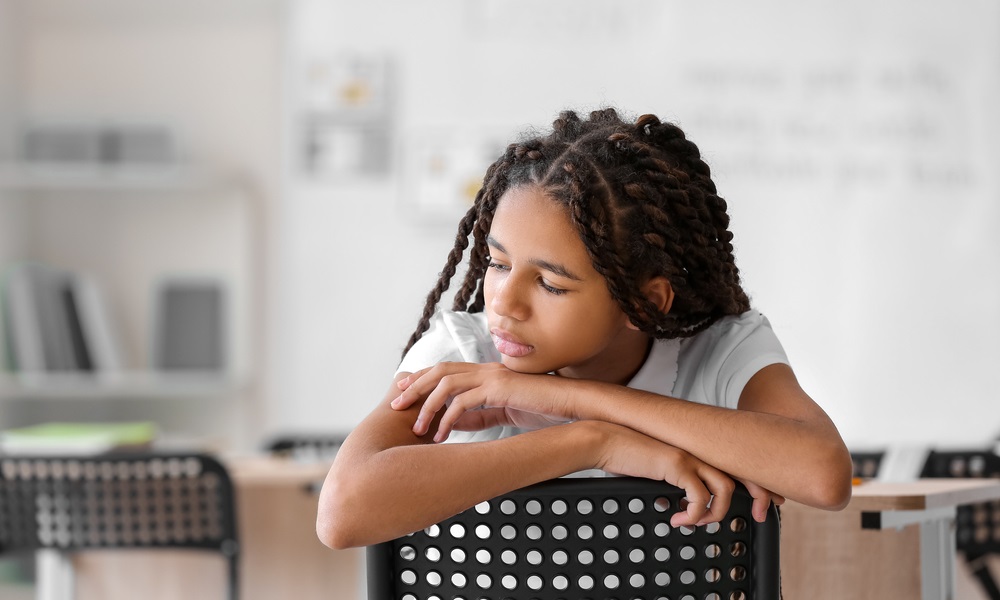Emergency room visits for suicidal thoughts and self-injury are on the rise, with Black girls and LGBTQ youth experiencing record rates of self-injury and death by suicide, mental health researchers and clinicians say.
“Black girls showed the largest annual percentage change in terms of suicide increase. We typically think that suicide is an older white male phenomenon,” said researcher Michael Lindsey, dean of the New York University Silver School of Social Work during a recent University of Southern California webinar about the youth mental health crisis.
He co-authored a May 2022 analysis, published in the Journal of the American Academy of Child & Adolescent Psychiatry, showing that, from 2003 to 2017, Blacks aged 15 to 17 and Black girls in that age group showed the “largest annual percentage changes” in suicides; those spikes were 4.9% and 6.6.%, respectively.
A relationship challenge was the most likely trigger for those deaths or attempted suicides, added Lindsey, who, with the other webinar panelists, stressed the need for schools, law enforcement agencies, families and youth to, collaboratively, reverse a spiral of depression, anxiety and other mental disorders that raise suicide risks.
Suicide is second-leading cause of all youth deaths
Between 2010 and 2020, steadily rising suicides resulted in that tragedy becoming the second leading cause of death for those aged 10 through 24 of all races, according to the American Academy of Pediatrics, American Academy of Child & Adolescent Psychiatry and Children’s Hospital Association, which jointly declared a national emergency in youth mental health.

Courtesy of Michael Lindsey
Michael Lindsey
That October 2021 declaration followed 2019’s “Ring the Alarm: The Crisis of Black Youth Suicide in America,” which found that suicides were rising faster in those youths than in any other racial group. NYU’s Lindsey led that research, which the Congressional Black Caucus commissioned. Self-reported suicide attempts increased 144% among Black youth from 1991 through 2019, even as they fell among non-Hispanic Whites.
Also on the heels of that 2021 emergency declaration was The Trevor Project’s 2022 report, concluding that 45% of the 34,000 13- to 24-year-olds in that survey had seriously considered suicide. One in three of them lived with people who affirmed their gender identity. Those whose family’s supported them attempted suicide at less than half of the rate of LGBTQ youth who reported receiving low or moderate support, according to Trevor Project researchers who did not respond to Youth Today’s request for comment about the analysis.
But NYU’s Lindsey said, “There is a lack of appreciation of how the kids are identifying, and painful caustic experiences that those kids are subjected to as they come into their own identity in terms of how they want to be reflected in the world.”
Witnessing violence, other unresolved trauma drives suicide
The most significant predictor of suicide is unresolved childhood traumas, including violence witnessed or experienced at home, in the community and at schools, mental health clinicians and researchers say.
“When we are talking about childhood trauma and grief, I have really been referring to this as a silent epidemic,” said clinical psychologist Julie Kaplow, executive director of the Children’s Hospital of New Orleans Trauma and Grief Center. “And that’s because so many of the mental and behavioral health struggles that we see today are really rooted in traumas and losses.”
In under-resourced communities those issues are more likely to go unaddressed, said Kaplow, also the executive vice president of trauma and grief programs for the Texas-based Meadows Mental Health Policy Institute and a Tulane University psychiatry professor.

Courtesy of Julie Kaplow
Julie Kaplow
“Sadly, in the under-resourced communities we see the cumulative effect of both acute traumas and chronic traumas going on all at the same time,” said Kaplow, who has been working in Uvalde, Texas, since May 24’s mass shooting at Robb Elementary School.
“Trauma,” she added, “is the experience of a real or perceived threat to the life or bodily injury to a loved one or to them. And this causes an overwhelming sense of terror, horror, helplessness and fear.”
NYU’s Lindsey said his research has confirmed that reality.
He also said he was startled by some of the findings from the Ring the Alarm. Of the youth in that study, 20% said they were thinking about suicide and 15% had a suicide plan.
“We looked at four indices: Thinking about suicide, planning a suicide, a suicide attempt and having an injury related to a suicide attempt that required hospitalization,” Lindsey said.
Girls, he added, were using potentially more lethal means by which to attempt suicide, Lindsey said.
For the last several years, Lindsey has been researching suicides and suicidal thoughts based on gender. He co-authored the 2017 article “Boys Don’t Cry: Addressing the unmet mental health needs of African Americans,” published in the American Journal of Orthopsychiatry.”
“But they do cry,” he said. “And the question is ‘Are we listening to the cries and are we attuned to their cries?’”
He cited racial bias, whether from law enforcement or vigilantes, among the larger problems that Black youth also confront.
“Hopelessness and related traumas,” Lindsey said, “are a third sociocultural factor that may be driving the increase in Black youth suicide.”
***
Ohio journalist Sonia Chopra’s byline has appeared in he Cincinnati Enquirer, Cosmopolitan, HuffPost, Rewire, Salon and Teen Vogue. She also has field-reported for The New York Times.




























